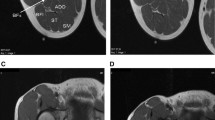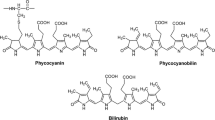Summary
The effect of pyridostigmine on thermoregulatory responses was evaluated during exercise and heat stress. Eight heat acclimated, young adult male subjects received four doses of pyridostigmine (30 mg) or identical placebo tablets every 8 h, in a double blind, randomized, cross-over trial. A 30.3%, SD 4.6% inhibition of the circulating cholinesterase (ChE) activity was induced in the pyridostigmine-treated group. The subjects were exposed to 170-min exercise and heat-stress (dry bulb temperature, 33° C; relative humidity 60%) consisting of 60 min in a sitting position and two bouts of 50-min walking (1.39 m · s−1, 5% gradient) which were separated by 10-min rest periods. No differences were found between treatments in the physiological responses and heat balance parameters at the end of exposure: heart rate (f c) was 141 beats · min−1, SD 16 and 150 beats · min−1, SD 12, rectal temperature (T re) was 38.5°C, SD 0.4° and 38.6°C, SD 0.3°, heat storage was 60 W · m−2, SD 16 and 59 W · m−2, SD 15 and sweat rate was 678 g · h−1, SD 184 and 661 g · h−1, SD 133, in the pyridostigmine and placebo treatments, respectively. The changes in T re and f c over the heat-exercise period were parallel in both study and control groups. Pyridostigmine caused a slight slowing of f c (5 beats·min−1) which was consistent throughout the entire exposure (P<0.001) but was of no clinical significance. The overall change in fc was similar for both groups. We have concluded that pyridostigmine administration, in a dose sufficient to induce a moderate degree of ChE inhibition, does not significantly affect performance of exercise in the heat.
Similar content being viewed by others
References
Aquilonius S, Eckernas SA, Hartvig P, Lindstrom B, Osterman PO (1980) Pharmacokinetics and oral bio-availability of pyridostigmine in man. Eur J Clin Pharmacol 18:423–428
Avlonitou E, Elizondo R (1988) Effect of atropine and pyridostigmine in heat-stressed patas monkeys. Aviat Space Environ Med 59:544–548
Breyer-Pfaff U, Maier U, Brinkmann AM, Schumm F (1985) Pyridostigmine kinetics in healthy subjects and patients with myasthenia gravis. Clin Pharmacol Ther 37:495–501
Burton AC (1935) Human calorimetry. II. The average temperature of the tissues of the body. J Nutr 9:261–280
Deyi X, Wang L, Shuqiu P (1981) The inhibition and protection of cholinesterase by physiostigmine and pyridostigmine against soman poisoning in vivo. Fundam Appl Toxicol 1:217–221
Drachman DB (1978) Myasthenia gravis. New Engl J Med 298:186–192
Dunn MA, Sidell FR (1989) Progress in medical defense against nerve agents. JAMA 262:649–652
Francesconi R, Hubbard R, Mager M (1984) Effects of pyridostigmine on ability of rats to work in the heat. J Appl Physiol 56:891–895
Francesconi R, Hubbard R, Matthew C, Leva N, Young J, Pease V (1986) Oral pyridostigmine administration in rats: effect of thermoregulation, clinical chemistry, and performance in the heat. Pharmacol Biochem Behav 25:1071–1075
Gall D (1981) The use of therapeutic mixtures in the treatment of cholinesterase inhibition. Fundam Appl Toxicol 1:214–216
Givoni B, Goldman RF (1972) Predicting rectal temperature response to work, environment, and clothing. J Appl Physiol 32:812–822
Glickson M, Karni A, Ram Z (1986) No hyperglycemia after pyridostigmine administration. J Appl Physiol 60:344
Heyl WC, Harris LW, Stitcher DL (1980) Effects of carbamates on whole blood cholinesterase activity: chemical protection against soman. Drug Chem Toxicol 3:319–332
Johnson CD, Ressel RL (1975) A rapid simple radiometric assay for cholinesterase, suitable for multiple determinations. Anal Biochem 64:229–233
Kamon E, Avellini B (1976) Physiologic limits to work in the heat and evaporative coefficient for women. J Appl Physiol 41:71–76
Lomax P, Kokka N, Lee RJ (1985) Acetylcholinesterase inhibitors and thermoregulation. In: Cooper KE, Lomax P, Schonbaum E, Veale WL (eds) Homeostasis and thermal stress. Karger, Basle, pp 108–112
Matthew CB, Hubbard RW, Francesconi RP, Glenn JT (1988) Carbamates, atropine, and diazepam: effects on performance in the running rat. Life Sci 42:1925–1931
Maxwell DM, Brecht KM, Lenz DE, O'Neill BL (1988) Effect of carboxylase inhibition on carbamate protection against soman toxicity. J Pharmacol Exp Ther 246:986–991
Mount ME, Oehme FW (1981) Diagnostic criteria for carbaryl poisoning in sheep. Arch Environ Contam Toxicol 10:483–495
Namba T, Nolte CT, Jackrel J, Grob D (1971) Poisoning due to organophosphate insecticides. Am J Med 50:475–492
Reiner E (1971) Spontaneous reactivation of phosphorylated and carbamylated cholinesterases. Bull WHO 44:109–112
Taylor HL, Buskirk E, Henschel A (1955) Maximal oxygen intake as an objective measure of cardiorespiratory performance. J Appl Physiol 8:73–80
Taylor P (1985) Anticholinesterase agents. In: Gilman AG, Goodman LS, Rall TW, Murad F (eds) The Pharmacological basis of therapeutics, 7th edn. Macmillan, New York, pp 110–129
Wenger CB, Latzka A (1989) Effect of pyridostigmine pretreatment on physiological responses to heat, exercise, and hypohydration. Proc Med Def Biosci Rev pp 841–844
Willems J, Vermeire P, Rolly G (1971) Some observations on severe human poisoning with organophosphate pesticides. Arch Toxicol 28:182–191
Wilson LB, Hatch MA, Ginsburg S (1960) Carbamylation of acetylcholinesterase. J Biol Chem 235:2312–2315
Author information
Authors and Affiliations
Rights and permissions
About this article
Cite this article
Epstein, Y., Arnon, R., Moran, D. et al. Effect of pyridostigmine on the exercise-heat response of man. Eur J Appl Physiol 61, 128–132 (1990). https://doi.org/10.1007/BF00236706
Accepted:
Issue Date:
DOI: https://doi.org/10.1007/BF00236706




